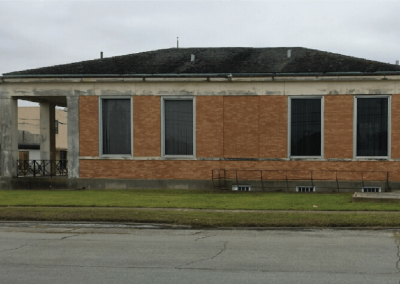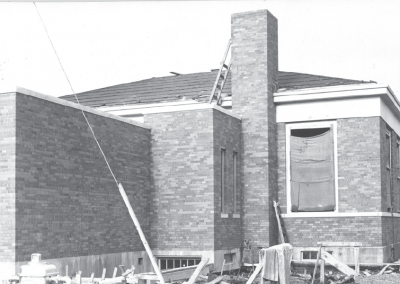HISTORIC PASADENA POST OFFICE
RESTORATION EFFORTS UNDERWAY
Our Post Office Restoration Project Featured on ABC13
Bob Harris Station, Federal Post Office
The Bob Harris Post Office was built on a site important to early Texas history. Construction of Post Office on a site selected by the Federal Works Agency that would serve the Houston Ship Channel industries and nearby farming communities and stimulate growth during the Great Depression. Mexican General Santa Anna was captured one mile north of this Post Office near the mouth of the San Jacinto River at the present day, Washburn Tunnel. One mile to the west was Vince’s Bridge which crossed Vince Bayou where General Sam Houston’s Texian Army and the Mexican Army marched over toward the battle of San Jacinto. “Then Houston crossed Vince’s Bayou on a small wooden bridge and realized that its destruction would create the perfect trap for those fleeing the battlefield. The approach to the bridge was on the road that was bounded by Buffalo Bayou on the right, Vince’s Bayou straight ahead, and Little Vince Bayou on the left. With the bridge over Vince’s Bayou destroyed, the fleeing Mexicans were forced into a bottleneck where they had to either try to swim the rain-swollen Vince’s Bayou, turn and fight, or surrender. As if Houston had anticipated and planned for, Santa Anna attempted to flee the battle with some of his officers and cavalry guard. The Texian cavalry gave hot pursuit and killed most along the road towards Harrisburg. At the burned bridge Santa Anna was forced to dismount and hid in the underbrush at dusk as he was afraid to cross what he described as “a large creek.” Most of those trying to swim across were shot by the Texians.”[1] The path they marched down was between present day Shaw and Sterling streets going towards La Porte. So, both armies passed over the area where the Post Office was built. The City of Pasadena has adopted the nickname, “The Birthplace of Texas.”
In 1888 the 15,000-acre Sam Allen Ranch in Harris County with property along Buffalo Bayou between Harrisburg and La Porte became an important route from Houston to La Porte and the Port of Galveston.[2] The Galveston, Harrisburg and Houston Railroad ran through the Allen Ranch. In 1892, Colonel John H. Burnett, a railroad builder, established townsites Deepwater and Genoa which were later incorporated into the City of Pasadena. Pasadena thrived along Buffalo Bayou and businesses sprung up along the railroad.
This area was positioned to prosper in the petroleum and paper industries because of the proximity to rivers, shipping lanes, oil fields and rail lines. With WWII and the war effort, the refineries along the recently dredged Houston Ship Channel produced the majority of petroleum needed for the war effort. The Goodyear Rubber Plant provided the rubber vital for defense vehicles. Other industries opened about the same the time the new post office opened, were the Crown Central Refinery, the Champion Paper Mill, the Sinclair Refinery, the Shell Refinery and the Houston Lighting and Power Plant which contributed to the war effort. The Post Office location on Munger Street between the Ship Channel and the railroad was selected to serve industry and farming.
The first post office in Pasadena was established in 1893. By 1938, even with The Great Depression going on, the 1938 receipts totaled $11,820. A national design competition for a post office was held by the Federal Works Agency, a Great Depression era agency, chose Carl F. Guenther’s winning design for small post offices to be used for the construction the Bob Harris station at 102 Munger Street in Pasadena.[3]
“The Post Office was built on a site 175-by-125 feet in size with a floor space of 3,833 square feet. Cost of the post office was $78,000 and was dedicated in 1940. This created jobs for many local workers and during the Depression and established an architecture anchor near the center of what was then the heart of the then Pasadena’s commercial district.”[4]
Supervising Architect of the Treasury Department, Louis A. Simons’ name is engraved on the cornerstone of the building. Simons’ works included the 1936 IRS Building in Washington D.C., Fort Knox and West Point US Bullion Depositories, twelve post offices in Wyoming built in 1934 using standardized USPO Plans, and over 100 Post Offices around the nation from California to New York. Many of his buildings have been designated by the National Registry of Historic Places.[5]
By 1943, the population of Pasadena had grown to 12,000 with several defense industries, with 74,000 people on the payroll within a 6-mile radius.[6] At the time, World War II was ongoing and with the Great Depression still on everyone’s mind, the post office became the bank for most of the workers. Banks were often not trusted during the Great Depression, since so many closed before people could withdraw their money. Workers followed the work across the country and the mail order service enabled them to send money to their families back home. Payroll checks were cashed, mail orders were purchased and mailed home. The mail money order business was so large that that a separate fenced off area of the Work Room (Finance Section) is shown on the original blueprints and two teller windows were dedicated to money orders. The concrete reinforced walk-in safe had a concrete “look out” over the safe where the Postmaster could keep watch.
From early photos, the Bob Harris station maintained a regal stature amongst the structures that grew around it. It stands in an historical area. In 1836 both Santa Ana’s and Sam Houston’s armies past through this location before and after the battle. Santa Ana’s capture was one mile to the north of the building.
Built during the Great Depression by the Federal Works Agency, the Post Office created good paying jobs for the unemployed. It was designed and intended to be the keystone for the town’s business section. The photographs of the concrete basement during construction show unpaved roads and small houses surrounding it.
Spindletop and the oil boom contributed to the demand of industrial jobs in the area, the WWII and it’s demand for fuel and rubber was starting and the Ship Channel was in business. The post office was in the center of commerce at the time.
When opened in 1941, mail was not delivered door to door. Residents had to go to the post office to get their mail. “The number of rented boxes grew from 68 in 1942 to more than 1,000 in 10 years.”[7]
The old post office “loggia” or porch with its’ six limestone clad columns offer shade at the east main entry. Steel double entry doors are centered in the loggia with 4-foot high coach lamps flanking the front doors. The building has 24’ high ceilings and 9’ high double hung windows could be opened to allow ventilation up to a well in the hip roof, which had windows operable by a crank on the ground floor. This created a chimney effect to cool the building in the days before air conditioning was prevalent. Additionally, a common practice in the region was to use oyster shells for lime for the cement of the concrete mix and crushed shells instead of the gravel, because shells were readily available. To this day, the concrete basement walls have no visible cracks.
“After decades of service the Bob Harris Station, Federal Post Office was a victim of both the city’s southward shift and the challenges faced by the Postal Service as electronic communication replaces mail as the way Americans keep in touch.”[8] J. Morales, Inc., an Architectural, Engineering and Surveying frim, plans to rehabilitate the building by abating all the asbestos, lead paint and mold. Highlighting the unique character of the building, we will create a space where designers can plan the next chapter of north Pasadena’s history and revitalize the community.
[2] C. David Pomeroy Jr. “Pasadena, The Early Years” Pomerosa Press pg. 15
[3] Houston Chronicle “Post Office for Sale,” March 30, 2010.
[4]“Post office received stamp of approval,” by Virginia Hahn, “Pasadena Citizen,” 1993.
[5] https://www.ranker.com/list/louis-a-simon-architecture/reference
[6] “Post office received stamp of approval,” by Virginia Hahn, “Pasadena Citizen,” 1993.
[7] “Post office received stamp of approval,” by Virginia Hahn, “Pasadena Citizen,” 1993.
[8] “Houston Chronicle “Post Office for Sale,” March 30, 2010.











